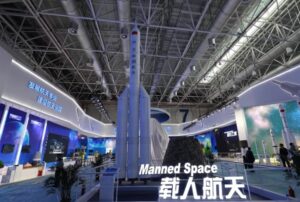China to develop two super-heavy launchers for moon missions
By Andrew Jones

HELSINKI — China will work on development of two types of super-heavy launch vehicles for future lunar projects, a senior official said Wednesday.
Jiang Jie, chief designer of the Long March 3A series of hypergolic launchers, told press (Chinese) in Beijing March 3 that the China Academy of Launch Vehicle Technology (CALT) would continue development of both a heavy launch vehicle and a new generation crew launch vehicle over the next five years.
The super-heavy launcher is known as the Long March 9. While various figures have been published, it is expected to be around 93 meters long, feature a 10-meter-diameter core and have a mass at liftoff of 4,140 metric tons.
Designed to be capable of lifting 140 tons to Low Earth orbit or 50 tons to trans-lunar injection, it will also feature four five-meter-diameter side boosters comparable to a Long March 5 first stage.
The project requires breakthroughs in larger diameter structures and high-thrust engines, Jiang said. China is developing dual nozzle 500 ton-thrust kerosene-liquid oxygen engines for the first stage, and a 220-ton-thrust liquid hydrogen-liquid oxygen staged combustion cycle engine for the second stage. A Long March 9 test flight is expected in 2030.
The new generation crew launch vehicle is expected to be a concept unveiled by the China Manned Space Agency in recent years.
The launcher is based on existing 5-meter-diameter cores of the Long March 5, China’s current largest launch vehicle, and uprated versions of its YF-100 keralox engines. However challenges are present in combining the components and technologies into a three-core launcher.
“The successful development of these two types of rockets will greatly enhance the ability of the country’s spacecraft to enter outer space,” Jiang said.
Jiang’s comments bring some clarity to the status of both Chinese super-heavy launchers. The emergence of the new crew launcher concept had sparked discussion as to whether it was an alternative to the Long March 9 or to be developed in parallel.
The Long March 9 is expected to be used for launching a lunar stack and infrastructure missions, as well as possible projects including space-based solar power.
CALT had previously set out a lunar mission concept involving launch of a Long March 9 followed by crew launching on a Long March 5B. A LEO rendezvous and docking would take place before TLI. However a new lunar landing architecture with the new crew launcher seems to have prevailed, with the Long March 9 providing support.
China last year tested a new-generation crew spacecraft capable of transporting astronauts beyond low Earth orbit, demonstrating a commitment to developing crewed lunar capabilities. The Chang’e-5 lunar sample return also adopted a complex mission profile involving a lunar orbit rendezvous and docking, verifying some of the techniques and technologies needed to get astronauts home from the moon.
China is also discussing the possibility of establishing an International Lunar Research Station with Russia. The project would build on the planned Chang’e-6, 7 and 8 missions and potentially lead to long-term human stays on the moon, suggesting China has serious, solidifying plans for using the new launchers.
Jiang was speaking in the capacity as a member of the National Committee of the Chinese People’s Political Consultative Conference (CPPCC), which runs alongside a legislative track to form China’s annual political sessions.
She is one of a dozen or more space industry representatives among 2,200 members of the CPPCC and 3,000 deputies to the legislative National People’s Congress (NPC).
The NPC is expected to pass a final version of China’s 14th five-year plan covering 2021-2025, outlining priorities for the period, at its conclusion on March 10. The new plan should provide new insight into China’s longer term space priorities and objectives, with a new “space white paper” to follow later in the year.
Luan Enjie, a senior space and lunar program official and former CNSA administrator, told state media last week that the Long March 9 was in the later stages of project approval.
He also stated his belief that space would become a vital part of life and infrastructure. “Astronautics will become a productive industry. Our satellites will become part of the space infrastructure, just like our highways, our power grid and our telecommunication network, serving our economy, serving the community…and serving all humanity,” Luan said.
March 3, 2021 at 06:56PM
via SpaceNews read more...

Post a Comment